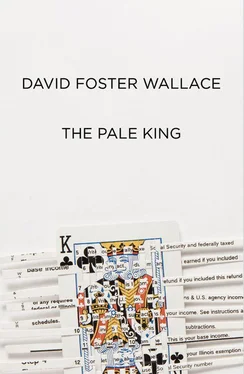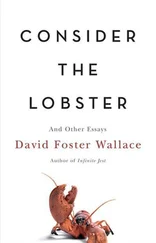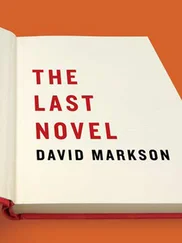2 This is a term of art; what I really mean is that everything that surrounds this Foreword is essentially true. The Foreword’s having now been moved seventy-nine pages into the text is due to yet another spasm of last-minute caution on the part of the publisher, re which please see just below.
3 At the advice of its corporate counsel, the publishing company has declined to be identified by name in this Author’s Foreword, despite the fact that anyone who looks at the book’s spine or title page will know immediately who the company is. Meaning it’s an irrational constraint; but so be it. As my own counsel has observed, corporate attorneys are not paid to be totally rational, but they are paid to be totally cautious. And it is not hard to see why a registered US corporation like this book’s publisher is going to be cautious about even the possibility of appearing to thumb its nose at the Internal Revenue Service or (this from some of the corporate counsel’s hysterical early memos) to be ‘abetting’ an author’s violation of the Nondisclosure Covenant that all Treasury employees are required to sign. Nevertheless — as my lawyer and I had to point out to them about 105 times before the company’s counsel seemed to get it — the version of the Nondisclosure Covenant that’s binding on all Treasury employees, not just on agents of the Bureau of Alcohol, Tobacco and Firearms and of the Secret Service, as formerly, was instituted in 1987, which happens to be the year that computers and a high-powered statistical formula known as the ANADA (for ‘Audit — No Audit Discriminant Algorithm’) were first used in the examination of nearly all individual US tax returns. I know that’s a pretty involved and confusing data-dump to inflict on you in a mere Foreword, but the crux here is that it is the ANADA, (a)and the constituents of its formula for determining which tax returns are most apt to yield additional revenue under audit, that the Service is concerned to protect, and that that was why the Nondisclosure Covenant was suddenly extended to IRS employees in 1987. But I had already left the Service in 1987. The worst of a certain personal unpleasantness had blown over, and I’d been accepted for transfer at another college, and by autumn of 1986 I was back on the East Coast and again up and running in the private sector, albeit of course still with my new SS number. My entire IRS career lasted from May 1985 through June 1986. Hence my exemption from the Covenant. Not to mention that I was hardly in a position to know anything compromising or specific about the ANADA. My Service post was totally low-level and regional. For the bulk of my time, I was a rote examiner, a.k.a. a ‘wiggler’ in the Service nomenclature. My contracted civil service rank was a GS-9, which at that time was the lowest full-time grade; there were secretaries and custodians who outranked me. And I was posted to Peoria IL, which is about as far from Triple-Six and the Martinsburg Center as anyone could imagine. Admittedly, at the same time — and this is what especially concerned the publishing company’s counsel — Peoria was a REC, one of seven hubs of the IRS’s Examination Division, which was precisely the division that got eliminated or, more accurately (though this is arguable), transferred from the Compliance Branch to the newly expanded Technical Branch, by the advent of the ANADA and a digital Fornix network. This is rather more esoteric, contextless Service information than I’d anticipated having to ask you to swallow right at the beginning, and I can assure you that all this gets explained and/or unfolded in much more graceful, dramatically apposite terms in the memoir itself, once it gets under way. For now, just so you’re not totally flummoxed and bored, suffice it to say that Examinations is the IRS division tasked with combing and culling various kinds of tax returns and classifying some as ‘20s,’ which is Service shorthand for tax returns that are to be forwarded to the relevant District office for audit. Audits themselves are conducted by revenue agents, who are usually GS-9s or -11s, and employed by the Audit Division. It’s hard to put all this very smoothly or gracefully — and please know that none of this abstract information is all that vital to the mission of this Foreword. So feel free to skip or skim the following if you wish. And don’t think the whole book will be like this, because it won’t be. If you’re burningly interested, though, each tax return pulled, for whatever reason(s) (some of which were smart and discerning and others, frankly, wacko and occult, depending on the wiggler), by a line examiner and forwarded for audit is supposed to be accompanied by an IRS Series 20 Internal Memo, which is where the term ‘20’ comes from. Like most insular and (let’s be frank) despised government agencies, the Service is rife with special jargon and code that seems overwhelming at first but then gets internalized so quickly and used so often that it becomes almost habitual. I still, sometimes, dream in Servicespeak. To return to the point, though, Examinations and Audits were two of the main divisions of the IRS’s Compliance Branch, and the publishing company’s house counsel’s concern was that the IRS’s own counsel could, if they were sufficiently aggrieved and wanted to make trouble over the Nondisclosure Covenant thing, argue that I and several of the Post 047 REC coworkers and administrators who feature in this story should be grandfathered in under the constraints of the Nondisclosure Covenant, because we were not only employed by the Compliance Branch but posted at the REC that ended up figuring so prominently in the run-up to what came to be known variously as ‘the New IRS,’ ‘the Spackman Initiative,’ or just ‘the Initiative,’ which was ostensibly created by the Tax Reform Act of 1986 but was actually the result of a long, very complicated bureaucratic catfight between the Compliance Branch and the Technical Branch over Examinations and the Exam function in IRS operations. End of data-dump. If you’re still reading, I hope enough of all that made sense for you to at least understand why the issue of whether or not I explicitly say the name of the publishing company was not one that I chose to spend a lot of time and editorial goodwill arguing about. You sort of have to pick your battles, as far as nonfiction goes.
(a) By the way, no kidding about the formula’s name. Were the Technical Branch statisticians aware that they were giving the algorithm such a heavy, almost thanatoid-sounding acronym? It’s actually doubtful. As all too many Americans now know, computerized programs are totally, maddeningly literal and nonconnotative; and so were the people in Technical Branch.
4 (excepting the ‘All rights reserved’ part, of course)
5 This latter is a good example of the sort of thing that threw the publisher’s legal people into a swivet of anality and caution. People often don’t understand how seriously large US corporations take even a threat of litigation. As I eventually realized, it’s not even so much a question of whether or not the publisher would lose a lawsuit; what really concerns them is the cost of defending against it, and the effect of those costs on the company’s liability insurance premiums, which are already a major operating expense. Legal trouble is, in other words, a bottom-line issue; and the editor or in-house counsel who exposes a publishing company to possible legal liability had better be able to demonstrate to his CFO that every last reasonable bit of caution and due diligence was exercised on the manuscript, lest he wear what we in Exams used to call ‘the brown helmet.’ At the same time, it isn’t fair to attribute every last tactical change and deviation here to the publisher. I (meaning, again, the actual human David Wallace) also fear litigation. Like many Americans, I’ve been sued — twice, in fact, though both suits were meritless, and one was dismissed as frivolous before I was even deposed — and I know what so many of us know: Litigation is no fun, and it’s worth one’s time and trouble to try to head it off in advance whenever possible. Plus, of course, looming over the whole vetting-and-due-diligence process on The Pale King was the shadow of the Service, which no one in his right mind would ever even dream of wanting to piss off unnecessarily, or actually even to come to the full institutional attention of, since the Service, like civil litigation, can make your life miserable without ever getting one extra dime from you.
Читать дальше












